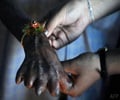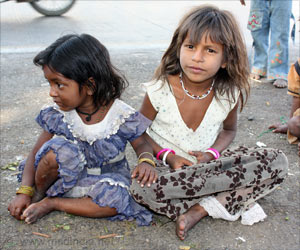Smita breaks down as she remembers the day she learned she had leprosy. I felt really bad, she says, wiping away tears. I didn't know what it was.
Smita breaks down as she remembers the day she learned she had leprosy. "I felt really bad," she says, wiping away tears. "I didn't know what it was."
The 42-year-old housewife was diagnosed with the disease in 2007 after discovering lesions on her face, knees and bottom. Then she began to lose sensation in her hands, making it difficult to eat, wash and cook.Smita, who asked that her real name not be used because of the stigma having leprosy still carries, lives in Mumbai, India's cosmopolitan financial and entertainment capital.
She has no idea how she caught an ancient disease that was officially declared eliminated here in 2004 and nationwide in 2005.
But she is not an isolated case. According to public health officials, there were more than 1,145 new cases of leprosy in Mumbai from February 2008 to March 2009, an increase from the 1,070 in 2007-08.
Most cases were in sprawling slum areas with poor or non-existent sanitation and where more than half of Mumbai lives, in particular migrant workers from north Indian states where the disease is not yet under control.
Leprosy prevalence in Mumbai is currently 0.53 cases per 10,000, well below the World Health Organisation (WHO) benchmark of one case per 10,000 people for the disease to be considered eliminated.
Advertisement
The Mumbai-based Foundation for Medical Research (FMR) has also said that leprosy prevalence is much higher than government statistics suggest.
Advertisement
Leprosy is a slowly progressing bacterial infection that affects the skin, peripheral nerves in the hands and feet, and mucous membranes of the nose, throat and eyes.
It is characterised by disfiguring skin sores, nerve damage and gradual debilitation.
Ganapati and the FMR blame the rise in new cases on the "false impression" that leprosy was eliminated, which has seen programmes specifically targeting the disease stopped or integrated with general health care services.
That has led to a decline in public awareness and a concomitant drop in early detection rates.
Doctors and non-governmental organisations like his are reporting a "rising trend" in leprosy in Mumbai and warn that other Indian cities with populations exceeding 10 million could be experiencing a similar situation, Ganapati said.
Further rises could put more pressure on NGOs for treatment, he told AFP.
Smita comes for treatment at the Bombay Leprosy Trust every other day.
The charity, set up by Ganapati in 1976, works out of rented premises near Dharavi -- often dubbed "Asia's largest slum" -- and survives on foreign donations for its research, training programmes and outreach work.
A team of medical students helps its two full-time doctors as salaries for leprosy doctors are not competitive with other posts.
Some of the 30 or so patients the doctors see each day sit in the shade under a corrugated plastic canopy at the back of the centre, waiting for check-ups and to be given blister packs of colourful drugs.
Pictures and signs on the walls in the local language, Marathi, provide health advice, including how to spot the first signs of leprosy, which is difficult to catch but can cause severe disability if not detected early.
All the patients look healthy enough, although one man points to a bright red, open sore on the side of his foot. Others have slight skin blemishes, the first sign of infection. One man has had a relapse after 11 years.
"There's a lot of work to be done to address this issue," said Dr Vivek Pai as he checked the leather splint designed to straighten out the clawed muscles on Smita's right hand.
"If we get patients within six months, we can reverse the effects on the nerves and muscles. After one year it's difficult, if not impossible."
Pai agreed with Ganapati that the recent lack of focus on leprosy has contributed to the rise in cases, despite an overall decline in the disease worldwide and it being easily treatable.
Leprosy rates fell below the one case in 10,000 benchmark across India in 2005 but there were still nearly 138,000 new cases in 2007-08, according to WHO and government statistics.
"There are rising cases because active work (in detection) has stopped. The focus is on voluntary reporting. That means a lot of time has been lost by the time they come and report. That's the issue," said Pai.
For Smita, a course of drugs has been effective in curing her leprosy, but two years since diagnosis she still needs regular physiotherapy on her nerve-damaged, disabled hand.
"The problem (of leprosy) is going to be there for many more years," said Ganapati. "The light at the end of the tunnel is by no means visible. It will take quite some time to reach a Utopian goal of a world without leprosy."
Source-AFP
LIN












